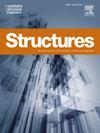Bonding techniques for CFRP-concrete interfaces: A comparative study of epoxy anchors and grooves with GO-modified epoxy
IF 3.9
2区 工程技术
Q1 ENGINEERING, CIVIL
引用次数: 0
Abstract
The present study investigates the effect of high-strength and low-concentrated GO-modified epoxy on the bond performance between CFRP-concrete interface with plain grinded and various configurations of epoxy anchors and grooves over the concrete surface. The 0.05 wt% GO-modified epoxy with grinded concrete surface outperforms the conventional CNT-modified epoxy and displayed cohesive failure with an increase in the ultimate debonding load and CFRP strain utilization by 28 % and 69.7 %, respectively. Epoxy grooves show better bonding characteristics at the CFRP-concrete interface than epoxy anchors. The optimized epoxy grooves configuration shows a 42 % and 100 % enhancement in the failure load and CFRP strain utilization, respectively, compared with the control specimen due to mechanical interlocking provided by anchors and grooves. Further, GO-modified epoxy in the optimized epoxy groove configuration shows a 59.3 % and 114.25 % remarkable increase in CFRP’s ultimate load, strain utilization, and complete concrete wedge failure. This significant enhancement is due to the combined effect of mechanical interlocking, friction, and chemical bonding. Most importantly, FE-SEM confirms the formation of a dense network between the interfaces due to an abundance of oxygen-containing functional groups in GO, which strengthens the load transfer path and results in improved bond behavior and effective and efficient composite action.
求助全文
约1分钟内获得全文
求助全文
来源期刊

Structures
Engineering-Architecture
CiteScore
5.70
自引率
17.10%
发文量
1187
期刊介绍:
Structures aims to publish internationally-leading research across the full breadth of structural engineering. Papers for Structures are particularly welcome in which high-quality research will benefit from wide readership of academics and practitioners such that not only high citation rates but also tangible industrial-related pathways to impact are achieved.
 求助内容:
求助内容: 应助结果提醒方式:
应助结果提醒方式:


